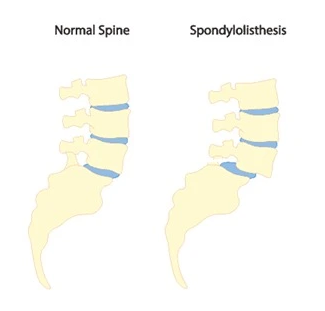Spondylolisthesis Simplified: Finding (your Spine’s) Balance
Our spine is like a stack of small bones called vertebrae. They’re held together by discs and ligaments in the front, and facet joints in the back. These facet joints act like hooks that link the top bone to the one below.
Understanding Spondylolisthesis
Spondylolisthesis happens when the top vertebra slips over the one below. This can occur due to different reasons.

Causes
Lytic Spondylolisthesis
The hook can break due to a fracture called pars lysis.
Degenerative Spondylolisthesis
The facet joints wear out and become less functional.
Disc Prolapse
The cushion between the bones, called the disc, fails to keep the bones together.
Dysplastic
When the hook, facet joints, bone, ligament, etc., don’t develop properly.
Impact of Spondylolisthesis
When the bones start slipping, it causes pain when moving the spine. This is known as instability back pain. Sciatica pain might occur if the nerve is stretched or damaged due to the slippage. In some cases, posture problems and even scoliosis can result, especially with the dysplastic type.
Who’s Affected
Females commonly experience this, and it can affect people of all ages based on the type. Adolescents might have the dysplastic type, the elderly can develop the degenerative type, and middle-aged individuals might experience the lytic type.
Managing the Issue
Instability back pain can be initially managed with a lumbo-sacral corset and exercises. Sciatica symptoms can be handled with injections and oral medicines. If initial treatments fail, fusion surgeries like TLIF, OLIF, ALIF, and PLIF might be needed.
Why Dr Ramachandran
Dr. Ramachandran approaches spondylolisthesis with a depth of understanding. He focuses on finding the right balance for each individual’s spine. His surgical strategies are guided by comprehensive assessments, including whole spine X-rays. By considering various parameters related to spinal balance and planning surgical levels meticulously, he ensures a well-informed approach to treatment.
Dr. Ramachandran’s proficiency extends to a range of Lumbar Fusion techniques, encompassing both traditional and minimally invasive options like MIS TLIF and OLIF. With a dedication to precision and a commitment to exploring the best path for each patient, he provides a reliable source of guidance and care for those dealing with spondylolisthesis.
